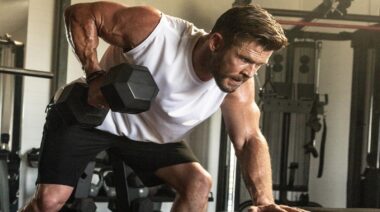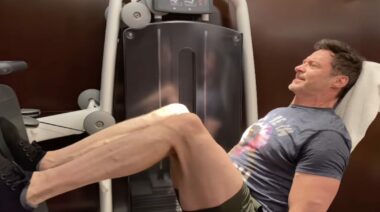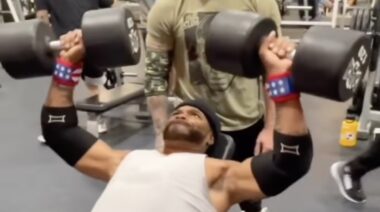One thing seldom talked about by weightlifters and weight trainers is the knurling on the bar. This happens despite the fact that we all come into contact with it every time we lay hands on the barbell. In truth, every athlete has his or her own preferences for knurling and every manufacturer has a different type of knurling (many have more than one type).
Knurling: The Barbells
Let’s look at the barbells first. The knurling on a barbell is ground onto the bar by means of a specialized machine. The pattern usually features two sets of diagonal lines, each set going in the opposite direction, so that they form thousands of tiny little diamonds. The center of those diamonds is some degree higher than the edge and that is what holds your grip. As might be imagined, the width of the grooves and their depth will determine the degree of what they call aggressiveness of the knurling. The exact pattern or angles of these lines makes no difference in its gripping ability.
Olympic Bars
Olympic bars generally have a finer gauge in their knurling. The men’s bar will also have knurling in the middle of the bar. This was used for one-handed lifts decades ago, but remains since lifters like to have a bit more gripping surface when doing squats. The women’s bar has no center knurling at all. The men’s bar is also usually a bit duller in the center because lifters do not want to tear their necks when turning the bar at the top of the clean. (If women want to squat they can use a men’s bar over sweats. The knurling won’t bother them and the men’s bar is stronger for squats anyway.)
Powerlifting Bars
Powerlifting bars generally have a more aggressive knurling to accommodate the needs of deadlifters pulling on much heavier weights. Knurling is not as important with the squat or bench press since the lifter is between the bar and the floor and the need for a solid grip is less. Power bars also have slightly more knurled distance. This will accommodate smaller lifters while it will not affect larger ones since the bar is not racked on the throat.
Standard Bars
 The standard barbells (I will not call them Olympic barbells despite their resemblance) used in commercial gyms and so-called wellness centers usually have very fine knurling. This is because the patrons of these establishments are not terribly concerned about lifting heavy weight and therefore do not need a solid grip on the bar. In addition they are more concerned with their bench presses than anything else. Many gyms do not allow deadlifts so they don’t need it for them either. As for squats or Olympic lifts it doesn’t matter one way or the other since few members are doing them in the first place.
The standard barbells (I will not call them Olympic barbells despite their resemblance) used in commercial gyms and so-called wellness centers usually have very fine knurling. This is because the patrons of these establishments are not terribly concerned about lifting heavy weight and therefore do not need a solid grip on the bar. In addition they are more concerned with their bench presses than anything else. Many gyms do not allow deadlifts so they don’t need it for them either. As for squats or Olympic lifts it doesn’t matter one way or the other since few members are doing them in the first place.
Knurling: The Lifters
Now let’s look at the lifters themselves. Each lifter has his or her favorite barbell with regards to its knurling characteristics. Some like fine knurling, while others prefer a more aggressive one. Much of this boils down to the lifter’s hand size. Smaller hands, whether male or female, need rougher bars if they’re going to maintain grip. The Uesaka bar has a reputation for being very rough but lifters with small hands prefer it. Bigger hands have more choice. The Eleiko bar has finer knurling and is favored by most lifters but especially those with bigger hands.
Whether they prefer sharp or dulled knurling, all lifters will quickly become familiar with callusing of the hands. Such calluses are not cause for alarm. They occur as part of the adaptation process. Human skin is not naturally adapted to handling a knurled barbell. But with a bit of training the hand does toughen up and produces a callus that will offer some protection to the underlying structures.
The problem is that this callus can keep on developing to the point that it is no longer serviced with blood or even nerve endings. The skin starts to dry out and when that happens ripping of these calluses can occur. This can result in live skin being pulled off as well as dead skin. When this happens the lifter will have to take a few days off of heavy pulling to allow the skin to grow back. Missing training in those circumstances is not good.
How do lifters handle this problem? One way is with the careful use of a razor, slicing or shaving away excess skin. Don’t worry, as the callous is now dead skin, it can be cut with no pain. A pumice bar might also be effective. These are resorted to by most lifters at some time or another.
The Dilemma of Using Gloves
 Another solution might be to use gloves on a rough bar. Even with finally knurled bars many trainees like to train with weight training gloves, which are pretty much the same as driving or cycling gloves. They have a bit of padding on the palms, and the fingers of the glove only extend as far as the knuckle of the first joint. The idea is that the trainee does not have to worry about getting calluses and even has a bit of padding to help with the pressure on the hands. That may be acceptable for most casual trainees.
Another solution might be to use gloves on a rough bar. Even with finally knurled bars many trainees like to train with weight training gloves, which are pretty much the same as driving or cycling gloves. They have a bit of padding on the palms, and the fingers of the glove only extend as far as the knuckle of the first joint. The idea is that the trainee does not have to worry about getting calluses and even has a bit of padding to help with the pressure on the hands. That may be acceptable for most casual trainees.
It may come as a surprise to many that the International Weightlifting Federation allows the use of such gloves in competition. This is surprising because a look at any competition photographs shows few, if any gloves in evidence. Why is this so? Why don’t lifters take advantage of the rules? This is because gloves in effect add extra diameter to the bar. This makes the bar more difficult to hold and therefore limits the amount that can be snatched or cleaned. In a sport that finds it necessary to have a 25mm bar for women and the 28mm one for men, the non-use of gloves should not be surprising. While it is probably true that women will be more worried about calluses on their hands if they were to use gloves, then the 25mm bar would quite likely end up thicker than the men’s 28mm bar, thus negating any advantage of the narrower bar. And don’t forget most women being smaller than most men will have smaller hands in the first place. So even with women you will seldom see gloves used in competition. As for the men? Forget it.
There is another reason why gloves are eschewed. Under the force of lifting a barbell even a tight-fitting pair of gloves will soon become an unstable intermediary between the hand and the barbell. This results in a loss of force transfer. Even in training gloves are seldom used. This is because during pulling exercises the hands are already protected with lifting straps. While these straps protect the hands from the bar knurling, they also increase the diameter of the bar. However this is not a problem since the straps also assist in gripping the bar.
For a lifter to be successful, he will have to get used to lifting with his bare hands through much of his workout. Straps can be used in the snatch because they can be released easily if the lift is lost backwards. Straps are not such a good idea in the clean because a lifter’s wrists and hands can get jammed if he cannot release the straps easily from bar. Of course straps are almost always used in snatch and clean pulls since the loads are heavy and will weaken a grip after the first rep. If the lifter deadlifts, he may or may not use straps depending upon the state of his grip strength.
But even if you use straps on the snatch, at some point prior to the competition you will have to jettison these. This is because a bare-hand lift feels considerably different from a lift using straps, to say nothing of the fact that you can lift more with straps than with a bare hand. So the lifter is then faced with the task of weaning himself off the straps and getting used to bare-hand lifting again.
In the final analysis you will just have to make friends with your bar’s knurling. Those who learn to live with a bit of callused hands are going to be the successful lifters.
Photos provided by CrossFit LA.






